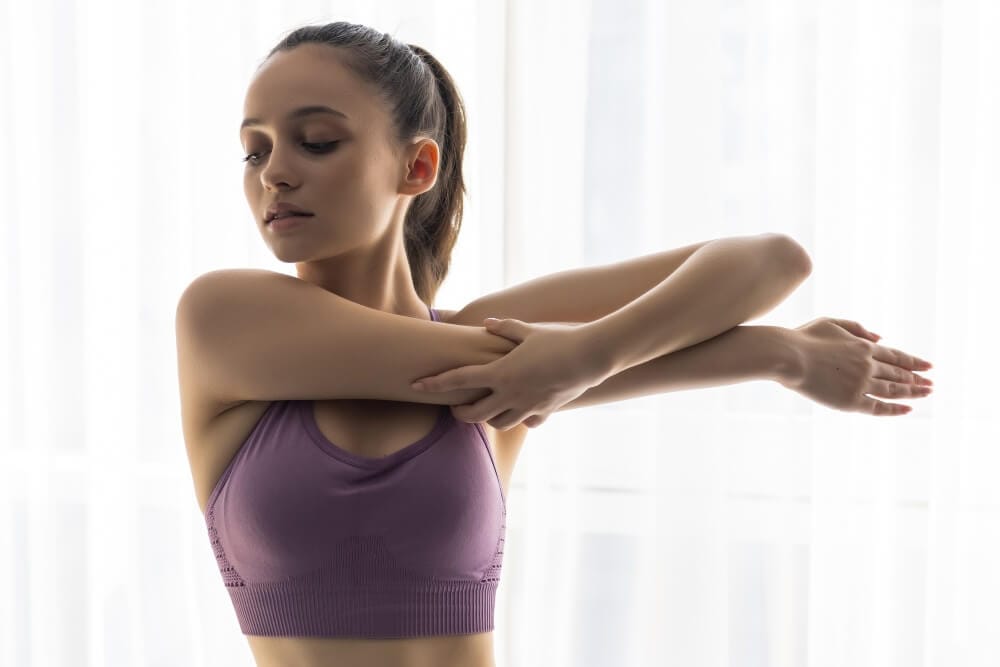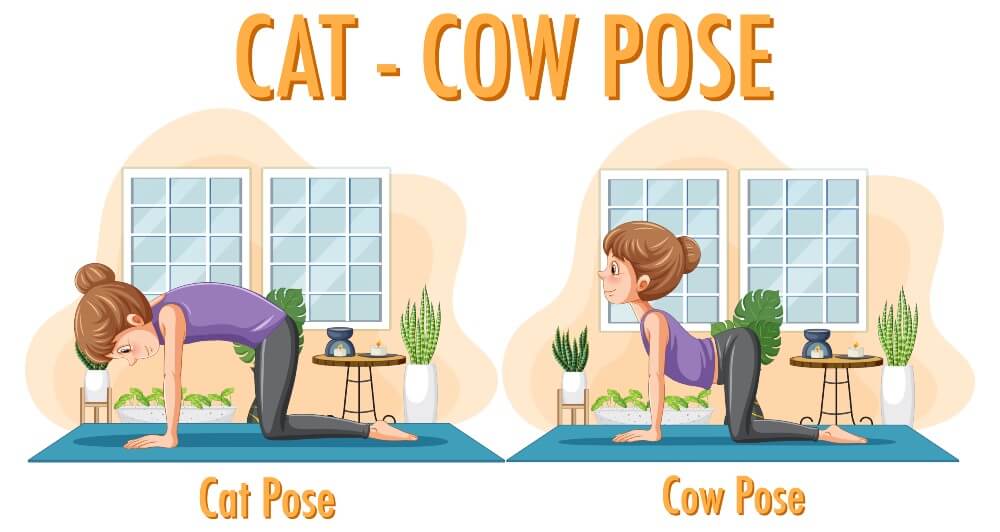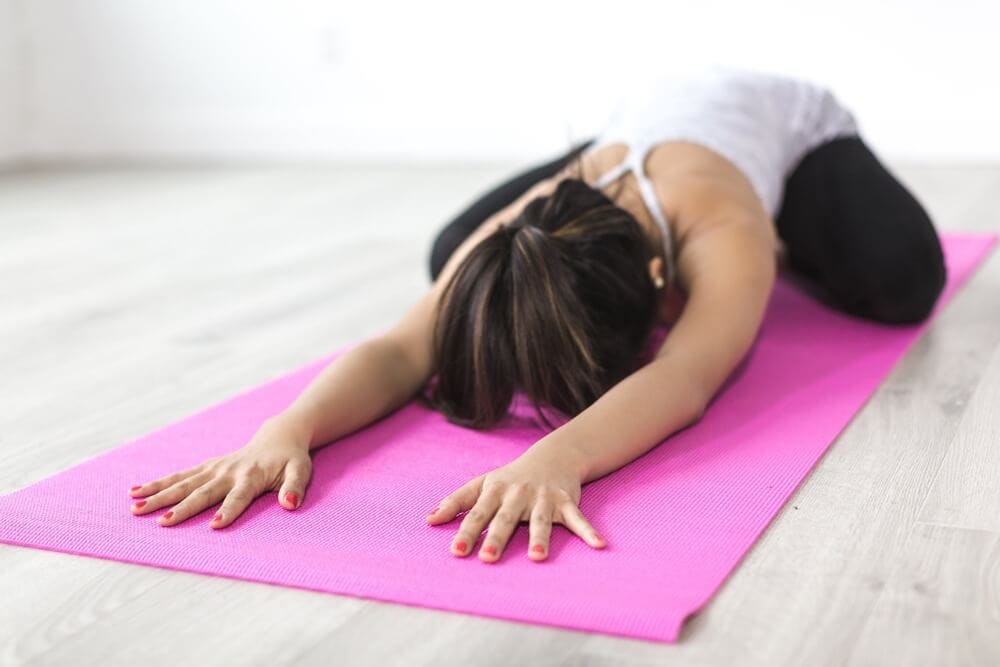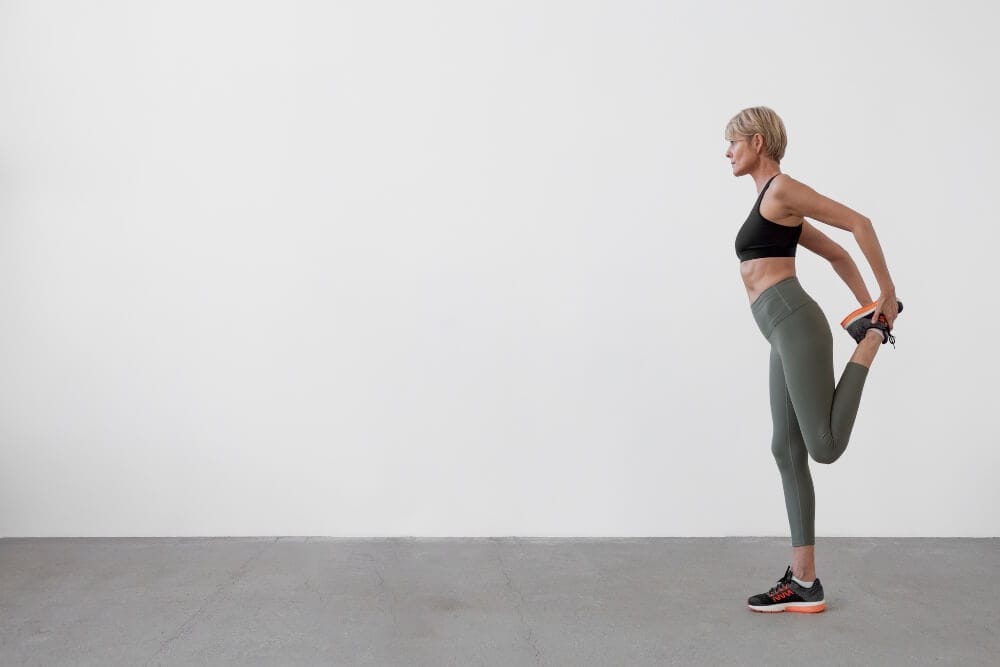Do you stretch regularly?
You should, because incorporating regular stretching into your fitness routine is essential for maintaining flexibility and preventing injuries.
Thanks to stretching you can target specific muscle groups and help them to stay flexible and healthy. Below is a comprehensive guide to the best stretching exercises for each major muscle group. Are you ready to read it?
1. How to stretch your neck?
- How to Perform: Sit or stand upright. Slowly tilt your head toward your right shoulder, aiming to bring your ear close without raising the shoulder. Hold for 15-20 seconds, then repeat on the left side.
- Benefits: Relieves tension in the neck and upper shoulders, improving flexibility and reducing the risk of strain.
2. Best shoulder stretching exercises
Across-Body Arm Stretch
- How to Perform: Bring your right arm across your body at chest level. Use your left hand to gently press your right arm closer to your chest. Hold for 15-20 seconds, then switch arms.
- Benefits: Enhances shoulder flexibility and range of motion, beneficial for activities and sports involving frequent overhead movements.

3. Best chest stretches
Chest Opener Stretch
- How to Perform: Stand with feet shoulder-width apart. Clasp your hands behind your back, straighten your arms, and gently lift them upward while pushing your chest forward. Hold for 15-20 seconds.
- Benefits: Opens up the chest muscles, counteracting the effects of prolonged sitting and improving posture.
4. How to stretch the upper back?
Cat-Cow Stretch
- How to Perform: Begin on all fours with your hands under shoulders and knees under hips. Inhale, dropping your belly and lifting your gaze (Cow Pose). Exhale, arching your spine upward and tucking your chin to your chest (Cat Pose). Repeat for 10 rounds.
- Benefits: Increases flexibility in the spine and stretches the back muscles, promoting better posture and relieving tension.

5. How to stretch lower back?
Child’s Pose
- How to Perform: Kneel on the floor with your big toes touching and knees hip-width apart. Sit back on your heels and extend your arms forward, lowering your torso between your thighs. Hold for 20-30 seconds.
- Benefits: Gently stretches the lower back, hips, and thighs, providing relief from lower back tension.

6. Best core stretches
Cobra Stretch
- How to Perform: Lie face down with your hands under your shoulders. Press into your hands to lift your chest off the ground, keeping your elbows slightly bent. Hold for 15-20 seconds.
- Benefits: Stretches the abdominal muscles and improves spinal flexibility.
7. Best stretch for hip flexor
Lunging Hip Flexor Stretch
- How to Perform: Kneel on your right knee with your left foot in front, forming a 90-degree angle. Shift your weight forward until you feel a stretch in the front of your right hip. Hold for 20-30 seconds, then switch sides.
- Benefits: Targets the hip flexors, which can become tight from prolonged sitting, improving hip mobility.
8. How to stretch glutes?
Figure-Four Stretch
- How to Perform: Lie on your back with your knees bent. Cross your right ankle over your left thigh. Grasp the back of your left thigh and gently pull it toward your chest. Hold for 20-30 seconds, then switch sides.
- Benefits: Stretches the gluteal muscles and piriformis, alleviating tension and enhancing hip flexibility.
9. How to stretch quadriceps?
Standing Quad Stretch
- How to Perform: Stand upright and grasp your right ankle behind you, pulling it toward your buttocks. Keep your knees close together and your back straight. Hold for 15-20 seconds, then switch legs.
- Benefits: Elongates the front thigh muscles, improving flexibility and reducing the risk of injury during activities like running or jumping.

10. How to stretch hamstrings?
Seated Hamstring Stretch
- How to Perform: Sit on the floor with your right leg extended and left foot against your inner right thigh. Reach toward your right toes, keeping your back straight. Hold for 20-30 seconds, then switch legs.
- Benefits: Enhances flexibility in the back of the thigh and reduces the risk of hamstring strains.
11. Good stretches for inner thighs
Butterfly Stretch
- How to Perform: Sit with your feet together and knees bent outward. Hold your feet and gently press your knees toward the floor. Hold for 20-30 seconds.
- Benefits: Targets the inner thigh muscles, improving flexibility and reducing the risk of groin injuries.
12. How to stretch calves?
Standing Calf Stretch
- How to Perform: Stand facing a wall with your hands pressed against it. Step back with your right leg, keeping it straight and your heel on the ground. Bend your left knee slightly and lean forward. Hold for 15-20 seconds, then switch legs.
- Benefits: Stretches the calf muscles, enhancing flexibility and preventing tightness.
13. Ankle mobility exercises
Ankle Circles
- How to Perform: Sit or stand with one leg lifted slightly off the ground. Rotate your foot clockwise for 10 circles, then counterclockwise for another 10. Switch to the other foot and repeat.
14. How to Stretch Your Feet?
Toe Stretch
- How to Perform: Sit on the floor with your legs extended. Bend one knee and place your foot flat on the floor. Use your hand to gently pull your toes back, stretching the underside of your foot. Hold for 15-20 seconds, then switch sides.
- Benefits: Feet stretch helps relieve tension in the arch and toes, improves foot flexibility, and can be especially beneficial for runners and those who spend a lot of time on their feet.
Frequently asked questions about stretching exercises
How long should you stretch?
For each muscle group, holding a static stretch for 15-30 seconds is generally sufficient. If the goal is to improve flexibility, stretches should be held for up to 60 seconds and repeated 2-3 times per muscle group. For dynamic stretching before a workout, aim for 5-10 minutes of continuous movement to properly warm up the muscles.
Is it better to stretch before or after a workout?
Generally, you should do warm up exercises before a workout. However, dynamic stretching (such as leg swings or arm circles) is best before a workout to warm up muscles and improve mobility. Static stretching (holding a stretch for 15-30 seconds) is more effective after a workout to improve flexibility and aid in muscle recovery.
Many people make mistakes such as overstretching or using incorrect techniques. Consulting a personal trainer can help you develop a safe and effective stretching routine tailored to your needs.
Can stretching help with muscle soreness?
Yes, stretching can help alleviate muscle soreness, but it won’t completely eliminate it. Gentle static stretching can increase blood flow to the muscles, helping with recovery and reducing stiffness. However, overstretching sore muscles can cause further irritation. Pair stretching with light movement, foam rolling, and proper hydration as it is the best approach to easing soreness.
Should I stretch every day?
Yes, daily stretching can be beneficial, but the intensity and type of stretching should depend on your activity level and goals. Gentle stretching every day helps maintain flexibility, improve posture, and reduce muscle stiffness. However, intense or deep stretching should be done 2-3 times per week to avoid overstretching and potential injuries.
If you’re an athlete or have tight muscles from sitting for long periods, daily mobility work (like dynamic stretching or yoga) can be especially helpful.
The key is to listen to your body and avoid pushing too hard.


